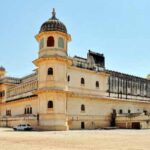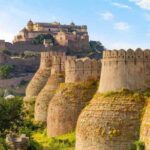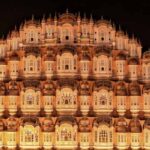29 Major Attractions in Rajasthan, a vibrant state in India, is famed for its rich cultural heritage and stunning architecture. The majestic Amber Fort in Jaipur, built with red sandstone and marble, offers a captivating blend of Hindu and Mughal architecture. Nearby, the City Palace stands as a testament to the opulence of Rajput rulers.
In Udaipur, the City of Lakes, the Lake Palace and City Palace offer picturesque views and intricate designs. The Mehrangarh Fort in Jodhpur, perched on a rocky hill, provides panoramic views of the city and houses a museum showcasing royal artifacts.
Jaisalmer, known as the Golden City, boasts the impressive Jaisalmer Fort, a UNESCO World Heritage site, and the enchanting Sam Sand Dunes, perfect for experiencing the Thar Desert’s vast expanse. The Pushkar Camel Fair in Pushkar is a vibrant cultural event, attracting visitors from around the world.
Rajasthan’s diverse attractions also include the wildlife at Ranthambore National Park, home to Bengal tigers, and the intricate Dilwara Temples in Mount Abu, renowned for their exquisite marble carvings. This state is a treasure trove of historical and cultural wonders, offering a memorable experience for every traveler.
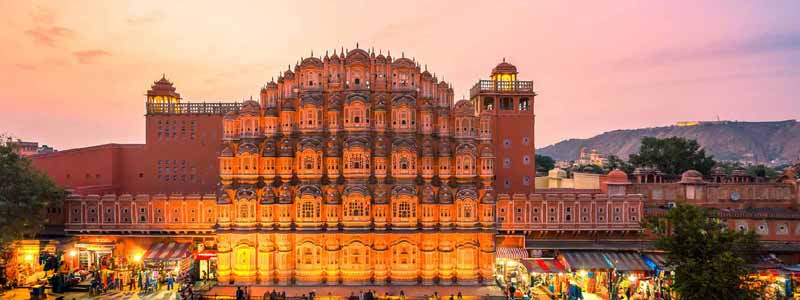
Jaipur
Jaipur, the capital city of Rajasthan, is a vibrant blend of historical and modern attractions, earning it the nickname “The Pink City.”
Amber Fort is a must-visit, known for its stunning architecture and scenic elephant rides up to the fort. This massive fort combines both Hindu and Mughal elements, offering a fascinating glimpse into India’s royal past.
Hawa Mahal, or the Palace of Winds, is an iconic structure with its unique five-story facade featuring 953 small windows. It was built for the royal ladies to observe street festivals while remaining unseen.
The City Palace in the heart of Jaipur is a beautiful complex of courtyards, gardens, and buildings, including the Chandra Mahal and Mubarak Mahal palaces. A portion of the palace is still a royal residence, while the rest has been converted into a museum.
Jantar Mantar, an astronomical observatory, houses the world’s largest stone sundial and is a UNESCO World Heritage site. It demonstrates the scientific advancements of the 18th-century Rajput king, Sawai Jai Singh II.
Jaipur is also known for its vibrant bazaars like Johari Bazaar and Bapu Bazaar, where visitors can shop for traditional Rajasthani jewelry, textiles, and handicrafts. The city’s lively culture, historic forts, and palaces make Jaipur a captivating destination for any traveler.
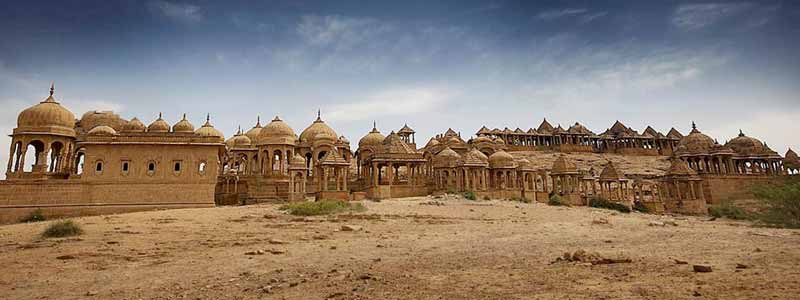
Jaisalmer
Jaisalmer, often referred to as the “Golden City,” is a remarkable destination in Rajasthan known for its distinctive yellow sandstone architecture and desert landscapes.
Jaisalmer Fort, also known as Sonar Quila or the Golden Fort, is a UNESCO World Heritage site and one of the largest fully preserved fortified cities in the world. Built in 1156 AD by the Bhati Rajput ruler Rawal Jaisal, the fort houses residences, temples, shops, and restaurants, all within its massive walls.
The Patwon Ki Haveli is an intricate cluster of five havelis and the most elaborate mansion in Jaisalmer. It features detailed carvings and expansive courtyards, reflecting the opulence of its merchant owners.
Sam Sand Dunes, located about 40 kilometers from Jaisalmer, offer an authentic desert experience with their vast, sweeping landscapes. Visitors can enjoy camel safaris, jeep tours, and cultural performances under the starlit sky.
Gadisar Lake, an artificial reservoir constructed by Maharaja Gadsi Singh in the 14th century, is a serene spot ideal for boating and bird watching. The lake is surrounded by temples and shrines, adding to its tranquil charm.
Nathmal Ki Haveli, known for its architectural fusion of Rajput and Islamic styles, showcases exquisitely carved exteriors and interiors. This haveli is still partially inhabited, providing a glimpse into the traditional lifestyle.
The Desert National Park, close to Jaisalmer, is a unique ecosystem where one can witness the diverse flora and fauna of the Thar Desert, including the great Indian bustard, an endangered bird species.
Jaisalmer’s enchanting mix of history, architecture, and desert adventures makes it a fascinating destination for travelers seeking to experience the essence of Rajasthan.
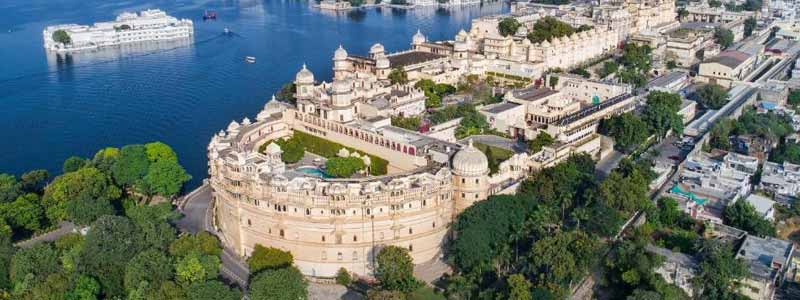
Udaipur
Udaipur, often called the “City of Lakes,” is one of Rajasthan’s most enchanting destinations, known for its stunning lakes, palaces, and rich history.
Lake Pichola is the centerpiece of Udaipur, offering boat rides that provide breathtaking views of the surrounding palaces and ghats. The lake’s serene waters and scenic beauty make it a popular spot for both tourists and locals.
City Palace, perched on the banks of Lake Pichola, is a magnificent complex showcasing a blend of Rajasthani and Mughal architecture. This sprawling palace, with its courtyards, terraces, and gardens, offers panoramic views of the city and the lake.
The Lake Palace, situated on Jag Niwas Island in Lake Pichola, is now a luxury hotel but remains a symbol of Udaipur’s romantic allure. Its white marble structure appears to float on the lake, creating a magical ambiance.
Jagdish Temple, a large Hindu temple dedicated to Lord Vishnu, is known for its stunning Indo-Aryan architecture. The temple’s intricate carvings and statues are a testament to Udaipur’s artistic heritage.
Saheliyon Ki Bari, or the Garden of the Maidens, is a beautiful garden adorned with fountains, kiosks, marble elephants, and a delightful lotus pool. It was built for the queen and her maids, offering a peaceful retreat.
Fateh Sagar Lake, another picturesque lake in Udaipur, is popular for boating and features three small islands, one of which houses the Nehru Park, a lovely garden and picnic spot.
Monsoon Palace, also known as Sajjangarh Palace, is perched on a hilltop overlooking Udaipur. It was built to watch the monsoon clouds and offers spectacular sunset views over the city and its lakes.
Udaipur’s unique charm lies in its blend of royal heritage, scenic beauty, and serene ambiance, making it a must-visit destination in Rajasthan.
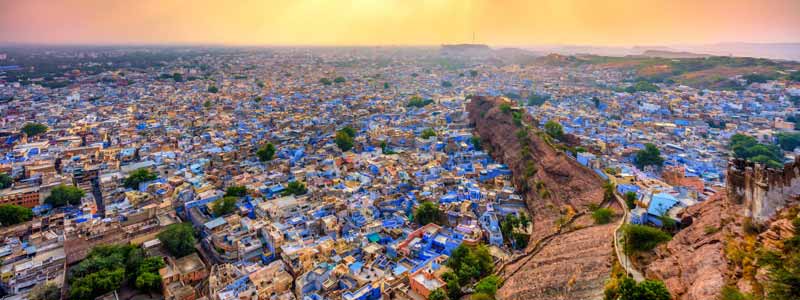
Jodhpur
Jodhpur, known as the “Blue City” due to the indigo-colored houses in its old town, is a captivating destination in Rajasthan renowned for its majestic forts, palaces, and vibrant culture.
Mehrangarh Fort, one of the largest forts in India, towers over the city from a 400-foot high hill. Built in the 15th century by Rao Jodha, the fort’s massive walls enclose palaces, museums, and courtyards showcasing artifacts and exhibits that depict the history and lifestyle of the Rathore dynasty.
Jaswant Thada, a cenotaph built in white marble, serves as a memorial to Maharaja Jaswant Singh II. Its intricate carvings and peaceful garden setting make it a serene spot to visit.
Umaid Bhawan Palace, a magnificent palace built with golden-yellow sandstone, is one of the world’s largest private residences. It blends Rajputana and European architectural styles and houses a museum showcasing artifacts and vintage cars.
Clock Tower and Sardar Market form the bustling heart of the old city. The vibrant market offers a lively atmosphere where you can shop for textiles, handicrafts, spices, and local sweets.
Mandore Gardens, located a short distance from the city center, house cenotaphs, temples, and gardens amidst lush greenery, making it a peaceful retreat.
The Rao Jodha Desert Rock Park, located at the base of Mehrangarh Fort, is a biodiversity park where you can explore and learn about the flora and fauna of the Thar Desert.
Jodhpur’s rich history, architectural marvels, and vibrant markets make it a fascinating destination that offers a glimpse into Rajasthan’s royal past and cultural heritage.
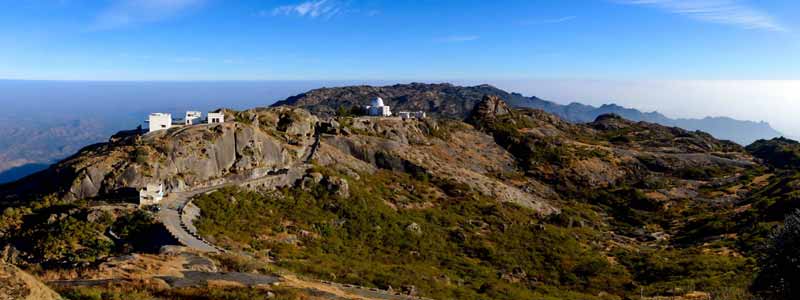
Mount Abu
Mount Abu, the only hill station in Rajasthan, is a serene retreat known for its cool climate, lush green surroundings, and rich cultural heritage.
Dilwara Temples, a group of exquisitely carved Jain temples, are the highlight of Mount Abu. Built between the 11th and 13th centuries, these temples are renowned for their intricate marble carvings that depict mythological scenes and celestial beings.
Nakki Lake, situated in the heart of Mount Abu, is a picturesque lake surrounded by hills and temples. Boating on Nakki Lake is a popular activity, offering serene views and a relaxing experience.
Guru Shikhar, the highest peak in the Aravalli Range, offers panoramic views of Mount Abu and its surroundings. The journey to Guru Shikhar includes a scenic drive and a short hike to reach the viewpoint.
Mount Abu Wildlife Sanctuary is home to a variety of flora and fauna, including rare species such as the Indian leopard and sloth bear. Visitors can enjoy wildlife sightings, nature walks, and birdwatching in the sanctuary.
Achalgarh Fort is an ancient fortress located about 11 kilometers from Mount Abu. It houses several temples, including the Achaleshwar Mahadev Temple, and offers panoramic views of the surrounding countryside.
Sunset Point and Honeymoon Point are popular viewpoints in Mount Abu where visitors can witness stunning sunsets and panoramic views of the hills and valleys.
Toad Rock, a rock formation resembling a toad, is a unique natural attraction located near Nakki Lake. It’s a popular spot for photography and enjoying scenic views of the lake and surrounding landscapes.
Mount Abu’s tranquil atmosphere, scenic beauty, and cultural attractions make it a popular destination for tourists seeking a peaceful getaway amidst Rajasthan’s desert landscape.
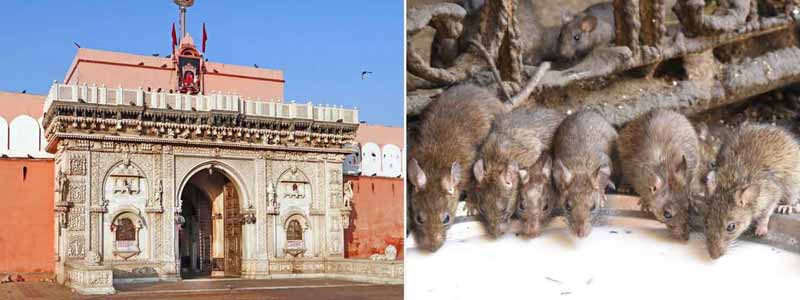
Bikaner
Bikaner, an enchanting city in the north-western part of Rajasthan, is renowned for its rich history, magnificent forts, and vibrant culture.
Junagarh Fort stands as a testament to Bikaner’s royal grandeur. Built in the 16th century by Raja Rai Singh, the fort is an architectural marvel with its intricate stone carvings, ornate palaces, and beautiful courtyards. It houses several palaces like Anup Mahal, Chandra Mahal, and Phool Mahal, each showcasing exquisite Rajput architecture and artifacts.
Lalgarh Palace is a magnificent palace built by Maharaja Ganga Singh in the early 20th century. This red sandstone palace blends Rajput, Mughal, and European architectural styles and now serves as a heritage hotel and museum displaying artifacts, photographs, and hunting trophies of the royal family.
Karni Mata Temple, located in the nearby Deshnoke town, is famous for its population of rats, considered sacred and worshipped by devotees. The temple’s unique ambiance and architectural style attract visitors from far and wide.
Bikaner Camel Festival is a vibrant cultural event held annually to celebrate the “ship of the desert,” the camel. The festival features camel races, camel beauty contests, traditional folk performances, and local handicrafts, offering a glimpse into Bikaner’s rich cultural heritage.
Gajner Palace and Lake, situated on the outskirts of Bikaner, is a former hunting lodge of the Bikaner royal family. The palace, surrounded by a lake and lush greenery, offers a serene retreat amidst nature and wildlife.
National Research Centre on Camel in Bikaner is dedicated to research and development related to camels, highlighting the importance of this animal in Rajasthan’s desert ecosystem.
Bikaner’s vibrant markets, such as Kote Gate and Bhujia Bazaar, are perfect for shopping traditional Rajasthani handicrafts, textiles, and the famous Bikaneri bhujia (spicy snack).
Bikaner’s blend of architectural splendor, cultural richness, and desert charm makes it a captivating destination for travelers exploring Rajasthan’s cultural tapestry, 29 Major Attractions in Rajasthan.
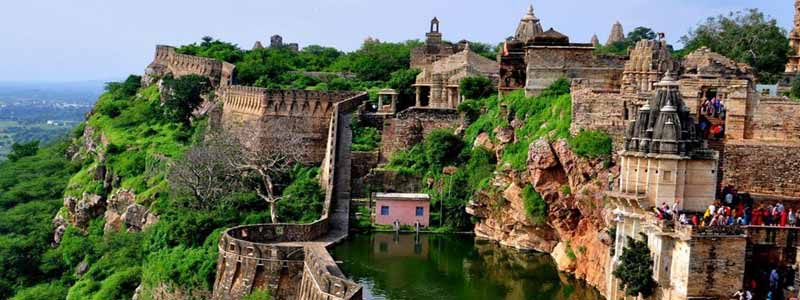
Chittorgarh
Chittorgarh, situated in the southern part of Rajasthan, is a city steeped in history and renowned for its majestic fort and tales of valor.
Chittorgarh Fort, one of the largest forts in India and a UNESCO World Heritage site, dominates the skyline with its massive walls, towers, and gates spread over a hilltop. This fort has witnessed several battles and is a symbol of Rajputana pride and resilience. Within its precincts are palaces, temples, and reservoirs, including the iconic Vijay Stambh (Tower of Victory) and Kirti Stambh (Tower of Fame), known for their intricate carvings and historical significance.
Rana Kumbha Palace, within Chittorgarh Fort, is a sprawling structure believed to be the birthplace of Maharana Udai Singh, the founder of Udaipur. It showcases Rajput architecture and offers panoramic views of the surrounding countryside.
Padmini Palace, situated in the southern part of the fort, is associated with the legendary tale of Rani Padmini, whose beauty captivated Sultan Alauddin Khilji and led to the siege of Chittorgarh.
Kalika Mata Temple is an ancient Hindu temple located near the fort, dedicated to Goddess Kali. It is believed to have been built in the 8th century and is a revered pilgrimage site.
Rani Padmini’s Palace or Padmavati Palace, another architectural gem within the fort complex, offers a glimpse into the royal lifestyle with its beautiful pavilions, gardens, and water features.
Kirti Stambh (Tower of Fame) is a seven-story tower adorned with Jain sculptures and carvings, built by a wealthy Jain merchant in the 12th century. It stands as a testament to Jain architectural prowess and devotion, 29 Major Attractions in Rajasthan.
Chittorgarh’s historical significance, architectural marvels, and tales of bravery make it a captivating destination for history enthusiasts and travelers exploring Rajasthan’s rich heritage.
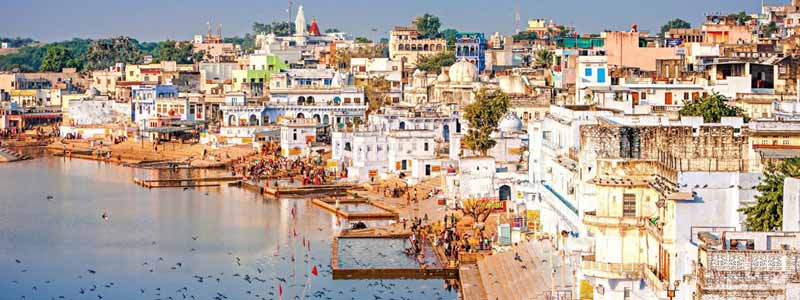
Pushkar
Pushkar, a sacred town in Rajasthan, is renowned for its spiritual significance, vibrant culture, and annual camel fair.
Pushkar Lake is the centerpiece of the town and considered one of the holiest lakes in India. According to Hindu mythology, it is believed to have been created by Lord Brahma. Pilgrims visit the lake to take ritual baths in its sacred waters, which are said to cleanse sins and bestow blessings.
Brahma Temple is one of the few temples in the world dedicated to Lord Brahma, the creator in Hindu mythology. This temple, built with marble and stone, features a red spire and intricately carved silver doors. It attracts devotees and tourists alike seeking blessings and spiritual solace.
Pushkar Camel Fair, held annually in November, is one of the largest camel fairs in the world and a unique cultural extravaganza. It brings together traders, farmers, and tourists to witness camel races, folk performances, camel beauty contests, and traditional Rajasthani music and dance. The fair also includes stalls selling handicrafts, textiles, and local cuisine, creating a vibrant atmosphere.
Savitri Temple is located on a hilltop overlooking Pushkar town and offers panoramic views of the surrounding desert landscape and Pushkar Lake. It is dedicated to Goddess Savitri, the wife of Lord Brahma, and is a popular pilgrimage site.
Pushkar Bazaar is a bustling market where visitors can shop for traditional Rajasthani handicrafts, jewelry, clothes, and souvenirs. The market’s lively atmosphere and vibrant colors reflect the town’s rich cultural heritage.
Pushkar Ghats are the series of steps leading down to Pushkar Lake, where pilgrims perform rituals and ceremonies. The ghats are also a serene place to observe religious activities and witness the daily life of locals, 29 Major Attractions in Rajasthan.
Pushkar’s blend of spirituality, cultural richness, and the annual camel fair makes it a unique destination that attracts travelers seeking both spiritual experiences and cultural immersion in Rajasthan.
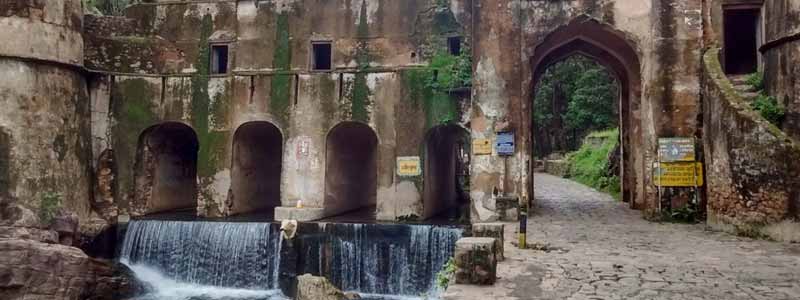
Sawai Madhopur
Sawai Madhopur, located in southeastern Rajasthan, is a town known primarily as the gateway to the world-renowned Ranthambore National Park.
Ranthambore National Park is one of the largest and most famous national parks in India, known for its population of Bengal tigers. The park’s varied terrain includes dense forests, grasslands, and ancient ruins, providing a unique backdrop for wildlife safaris. Visitors can spot not only tigers but also leopards, wild boars, deer, and a variety of bird species.
Ranthambore Fort, a UNESCO World Heritage site, is located within Ranthambore National Park. This ancient fort dates back to the 10th century and offers panoramic views of the park and surrounding landscape. The fort’s well-preserved structures, temples, and reservoirs reflect its historical and architectural significance.
Surwal Lake is a picturesque lake located near Sawai Madhopur, known for its scenic beauty and birdwatching opportunities. During the winter months, the lake attracts migratory birds, adding to its charm as a natural sanctuary.
Ganesh Temple is a revered Hindu temple dedicated to Lord Ganesha, located near Ranthambore Fort. It is a popular pilgrimage site and offers a peaceful setting amidst the rugged landscape.
Trinetra Ganesh Temple is another significant temple within the Ranthambore Fort complex, dedicated to Lord Ganesha. It is believed to be one of the oldest temples in Rajasthan and attracts devotees and tourists alike.
Khandar Fort is an ancient fort located about 40 kilometers from Sawai Madhopur. It offers historical insights and scenic views of the surrounding countryside, making it a worthwhile excursion for history enthusiasts.
Sawai Madhopur’s main draw lies in its proximity to Ranthambore National Park, offering wildlife enthusiasts and nature lovers a chance to experience the rich biodiversity and natural beauty of Rajasthan’s wilderness, 29 Major Attractions in Rajasthan.
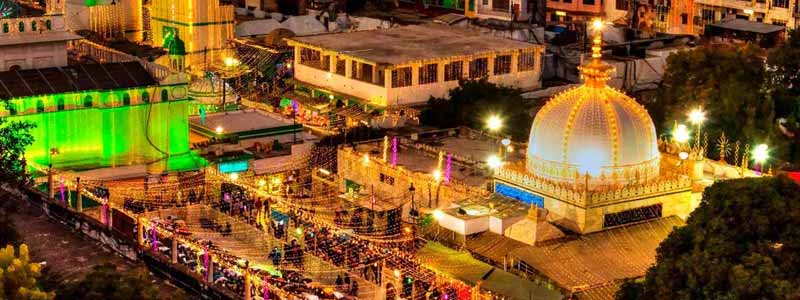
Ajmer
Ajmer, located in the heart of Rajasthan, is a city known for its religious significance, historical monuments, and vibrant culture.
Ajmer Sharif Dargah is the most famous attraction in Ajmer, revered by both Muslims and people of other faiths. It is the shrine of Sufi saint Khwaja Moinuddin Chishti, who played a significant role in spreading Sufism in India. The dargah attracts pilgrims from all over the world who come to seek blessings and offer prayers.
Ana Sagar Lake is a beautiful artificial lake built by Anaji Chauhan, the grandfather of Prithviraj Chauhan. It offers a peaceful retreat with manicured gardens, marble pavilions, and boating facilities, making it a popular spot for locals and tourists alike.
Adhai Din Ka Jhonpra is an ancient mosque and an architectural marvel located on the outskirts of Ajmer. Its name translates to “two and a half days’ hut,” referring to the legend that it was constructed in just two and a half days.
Taragarh Fort, also known as the Star Fort, is perched on a hilltop overlooking Ajmer. It offers panoramic views of the city and surrounding hills. The fort is known for its massive walls, reservoirs, and the Bhim Burj, a large cannon.
Nasiyan Jain Temple, also called the Red Temple, is an important Jain temple known for its stunning architecture and intricate designs. It houses a fascinating display of the Jain concept of the universe through a series of dioramas made from gold, silver, and precious stones.
Akbari Fort & Museum is a historical fort built by Mughal Emperor Akbar in Ajmer. It now houses a museum that displays artifacts, weapons, and paintings from the Mughal and Rajput periods, providing insights into the region’s history.
Mayo College is one of India’s oldest and most prestigious public schools, located in Ajmer. It has a colonial-era architecture and is known for its educational excellence and historical significance.
Ajmer’s blend of spirituality, history, and architectural splendor makes it a compelling destination for travelers interested in exploring Rajasthan’s cultural diversity and heritage, 29 Major Attractions in Rajasthan.
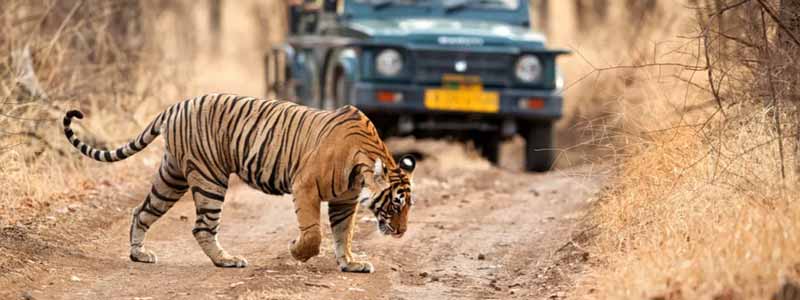
Ranthambore
Ranthambore, located in southeastern Rajasthan, is renowned worldwide for its tiger population and is one of the largest and most popular national parks in India.
Ranthambore National Park spans over 1,300 square kilometers and is characterized by its diverse landscape of deciduous forests, hills, lakes, and ancient ruins. It is particularly famous for its Bengal tigers, which can often be spotted during safaris. The park is also home to other wildlife such as leopards, sloth bears, wild boars, sambar deer, and various bird species.
Ranthambore Fort, a UNESCO World Heritage site, towers majestically over the national park. Dating back to the 10th century, this ancient fort offers panoramic views of the surrounding area and houses historical structures, temples, and reservoirs. The fort’s strategic location atop a hill adds to its allure and historical significance.
Safari Experience: Visitors to Ranthambore can embark on thrilling wildlife safaris, both in open jeeps and canters, to explore the park’s rich biodiversity. Safaris are conducted in different zones of the park, each offering unique landscapes and wildlife sightings.
Padam Talao and Rajbagh Talao are two prominent lakes within the park where wildlife, especially tigers, often gather. These lakes provide scenic spots for photography and wildlife observation.
Jungle Walks and Nature Trails: Apart from safaris, Ranthambore offers opportunities for guided jungle walks and nature trails, allowing visitors to explore the flora and fauna up close and learn about the ecosystem of the region, 29 Major Attractions in Rajasthan.
Surwal Lake: Located near the town of Sawai Madhopur, near the park, Surwal Lake is a picturesque spot known for birdwatching and serene natural surroundings.
Local Culture: Nearby villages and towns offer glimpses of rural Rajasthan’s culture and traditions. Visitors can experience local cuisine, folk music, dance performances, and interact with communities to gain insights into their way of life.
Ranthambore’s combination of wildlife, history, and natural beauty makes it a must-visit destination for wildlife enthusiasts, nature lovers, and anyone seeking an unforgettable experience in Rajasthan.
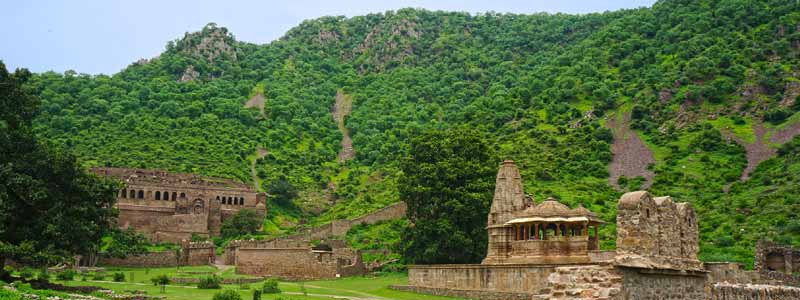
Alwar
Alwar, located in northeastern Rajasthan, is a city steeped in history, known for its forts, palaces, wildlife sanctuary, and cultural heritage.
Bala Quila or Alwar Fort is a majestic fort overlooking the city of Alwar. Built in the 15th century by Hasan Khan Mewati, the fort offers panoramic views of the surrounding Aravalli hills and the city below. It houses several palaces, temples, and reservoirs within its expansive walls.
City Palace in Alwar is a blend of Rajput and Mughal architectural styles. It houses a museum showcasing artifacts, weapons, paintings, and manuscripts from the region’s history, providing insights into Alwar’s royal heritage.
Sariska Tiger Reserve, located near Alwar, is a popular wildlife sanctuary known for its population of Bengal tigers. The sanctuary also hosts various other wildlife species such as leopards, hyenas, jackals, and numerous bird species. Jeep safaris and nature walks allow visitors to explore the sanctuary’s diverse ecosystems.
Siliserh Lake and Palace is a picturesque spot near Alwar, surrounded by hills and forests. The lake offers boating facilities, and the palace, built by Maharaja Vinay Singh in the 19th century, provides a serene retreat with its scenic beauty and tranquil ambiance.
Vinay Vilas Mahal is another architectural gem in Alwar, known for its grandeur and intricate marble work. It reflects the opulence of the region’s erstwhile rulers and houses a collection of artifacts and artworks.
Moosi Maharani ki Chhatri, a cenotaph dedicated to Maharaja Bakhtawar Singh and his queen, Moosi Maharani, is an architectural marvel with its intricately carved marble domes and pillars. It is located amidst beautiful gardens and serves as a peaceful memorial.
Alwar Bazaar and Hope Circus are bustling markets in the city where visitors can shop for traditional Rajasthani handicrafts, textiles, jewelry, and local delicacies, offering a glimpse into the vibrant local culture, 29 Major Attractions in Rajasthan.
Alwar’s rich history, architectural splendor, wildlife sanctuary, and scenic landscapes make it a captivating destination for history buffs, nature lovers, and travelers exploring Rajasthan’s cultural and natural heritage.
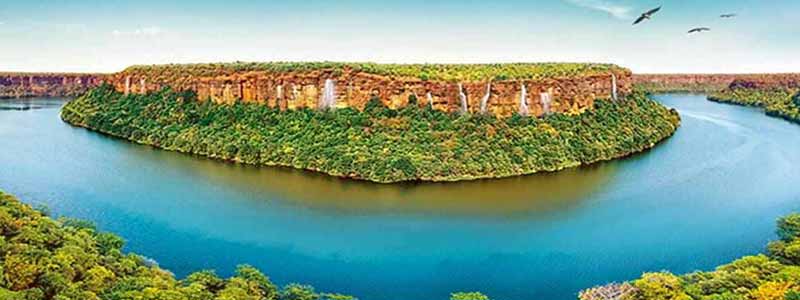
Kota
Kota, located in southeastern Rajasthan along the banks of the Chambal River, is known for its rich history, architectural marvels, educational institutions, and vibrant culture.
City Palace, or Garh Palace, is one of the most prominent landmarks in Kota. This sprawling palace complex features a blend of Rajput and Mughal architecture with its imposing gates, courtyards, gardens, and intricately designed rooms. The palace houses the Maharao Madho Singh Museum, which exhibits a diverse collection of artifacts, paintings, weapons, and sculptures reflecting Kota’s royal heritage.
Chambal Garden, situated along the banks of the Chambal River, is a popular recreational spot in Kota. The garden features lush greenery, beautiful fountains, and a serene boating lake, making it a perfect place for picnics and leisurely walks.
Kota Barrage, also known as Chambal River Dam, is an engineering marvel built across the Chambal River. It serves as a reservoir for irrigation and provides a picturesque setting for visitors to enjoy scenic views and water activities.
Seven Wonders Park in Kota is a unique attraction featuring replicas of the world’s seven wonders, including the Taj Mahal, Eiffel Tower, Statue of Liberty, and Great Wall of China. It offers a fascinating glimpse into these iconic structures within a single park.
Kishore Sagar Lake and Jagmandir Palace are located in the heart of Kota city. The artificial lake is surrounded by lush gardens and a scenic island palace, offering a tranquil escape amidst urban surroundings.
Garadia Mahadev Temple, located about 40 kilometers from Kota, offers stunning panoramic views of the Chambal River valley and its rugged cliffs. It is a popular destination for nature lovers and photography enthusiasts.
Kota Doria sarees and textiles are renowned for their fine cotton and silk weaves, adorned with traditional Kota dori (tiny square patterns). Visitors can explore local markets like Rampura Bazaar to shop for these exquisite textiles, along with handicrafts and jewelry, 29 Major Attractions in Rajasthan.
Kota’s blend of historical landmarks, natural beauty, educational institutions, and cultural attractions makes it a fascinating destination for travelers exploring Rajasthan’s diverse offerings.
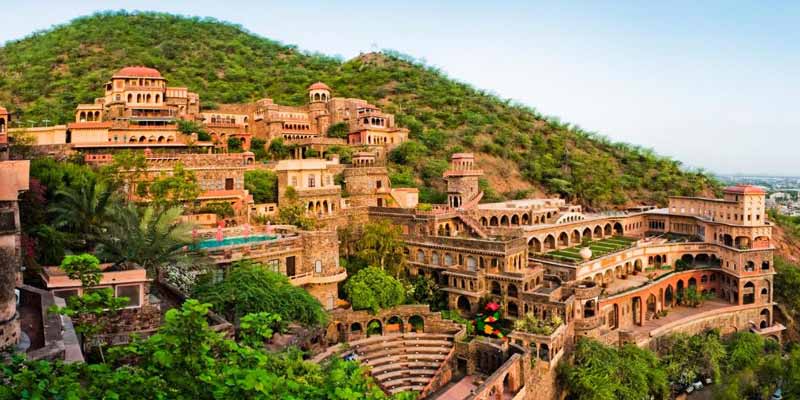
Neemrana
Neemrana, located in the Alwar district of Rajasthan, is a historical town known for its majestic Neemrana Fort Palace, which is now a popular heritage hotel and tourist attraction.
Neemrana Fort Palace is a 15th-century fort that has been converted into a luxurious hotel. Perched atop a hill, the fort offers panoramic views of the surrounding countryside and provides a glimpse into Rajasthan’s regal past with its beautifully restored rooms, courtyards, and gardens. Visitors can stay overnight at the palace hotel, enjoying modern amenities while experiencing the charm of staying in a historical fort.
Zip Lining: Neemrana is also famous for its thrilling zip lining experience, known as the Flying Fox Neemrana. Adventure enthusiasts can soar over the Aravalli hills and get a bird’s-eye view of the fort and its surroundings.
Baori: Neemrana is home to an ancient stepwell, or baori, known as the Neemrana Baori. Stepwells were traditionally used to store water and provide a cool respite from the desert heat. The Neemrana Baori is a remarkable example of traditional Rajasthani architecture and engineering.
Local Markets: Neemrana offers opportunities to explore local markets where visitors can shop for handicrafts, textiles, and traditional Rajasthani artifacts. The markets provide a glimpse into local culture and craftsmanship.
Bala Quila: While technically in Alwar, Bala Quila (Alwar Fort) is relatively close to Neemrana and worth visiting if you’re in the area. This majestic fort offers stunning views and a glimpse into the region’s historical significance, 29 Major Attractions in Rajasthan.
Neemrana’s combination of historical charm, adventure activities, and cultural experiences makes it a unique destination for travelers seeking a blend of heritage and modern excitement in Rajasthan.
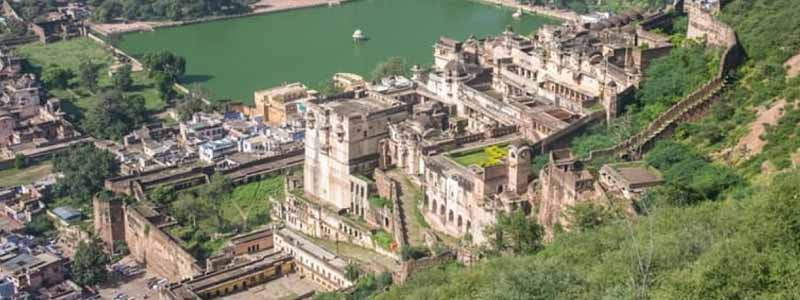
Bundi
Bundi, located in the Hadoti region of Rajasthan, is a picturesque town known for its intricate step wells, historical forts, palaces, and vibrant culture.
Taragarh Fort, also known as the Star Fort, is one of the main attractions in Bundi. Perched on a hilltop overlooking the town, this ancient fort offers panoramic views of Bundi and its surroundings. It is known for its massive battlements, reservoirs, and the Bhim Burj, a large cannon.
Step Wells: Bundi is famous for its step wells, known locally as “baoris.” The Rani Ji Ki Baori and Nawal Sagar Baori are notable examples, featuring elaborate carvings, architectural details, and cool, serene atmospheres. These step wells served as water reservoirs and community gathering places in the past.
Bundi Palace, or Garh Palace, is a majestic structure located adjacent to Taragarh Fort. It showcases Rajput architecture with its intricately decorated chambers, frescoes, and balconies. The palace also houses the Chitrashala, a gallery of vibrant frescoes depicting mythological and historical scenes.
Chaurasi Khambon ki Chhatri, or the 84 Pillared Cenotaph, is another architectural gem in Bundi. This cenotaph features 84 intricately carved pillars and domes, making it a unique and picturesque monument.
Nawal Sagar Lake is a large artificial lake in Bundi, overlooked by Taragarh Fort and surrounded by step wells and temples. The lake’s charm lies in its serene ambiance and reflection of the surrounding architectural marvels.
Local Markets: Bundi’s local markets offer an array of traditional Rajasthani handicrafts, textiles, and jewelry. Visitors can explore these markets for souvenirs and local specialties.
Bundi Painting: The town is also known for its distinctive style of miniature painting, characterized by intricate detailing and vibrant colors. Visitors can explore workshops and galleries to appreciate and purchase these traditional artworks.
Bundi’s rich history, architectural splendor, and cultural heritage make it a captivating destination for travelers interested in exploring Rajasthan’s lesser-known gems, 29 Major Attractions in Rajasthan.
Bharatpur
Bharatpur, located in eastern Rajasthan, is renowned for its Keoladeo National Park, a UNESCO World Heritage site and one of the finest bird sanctuaries in the world.
Keoladeo National Park, formerly known as Bharatpur Bird Sanctuary, is a haven for bird enthusiasts and nature lovers. It hosts over 370 bird species, including migratory birds from Central Asia, Siberia, and Europe during the winter months. The park is also home to numerous resident bird species, such as painted storks, kingfishers, herons, and eagles. Visitors can explore the park on foot, bicycle, or through guided rickshaw rides to observe birds in their natural habitats.
Lohagarh Fort, or the Iron Fort, is an ancient fortification located in Bharatpur. It is renowned for its robust structure, built with iron and stones, which withstood several attacks by the British in the 18th century. The fort offers insights into Bharatpur’s historical significance and provides panoramic views of the surrounding landscape.
Deeg Palace, situated about 32 kilometers from Bharatpur, is a stunning palace complex known for its Mughal-style gardens, water fountains, and pavilions. Built by Maharaja Suraj Mal in the 18th century, the palace served as a summer retreat for the rulers of Bharatpur and hosts an annual cultural festival showcasing traditional music and dance.
Bharatpur Government Museum houses a collection of artifacts, sculptures, coins, and manuscripts related to the region’s history and culture. It offers visitors a deeper understanding of Bharatpur’s heritage and archaeological significance.
Bharatpur Markets offer a variety of local handicrafts, textiles, jewelry, and traditional Rajasthani items. Visitors can explore these markets to shop for souvenirs and experience the local flavors and crafts of the region, 29 Major Attractions in Rajasthan.
Bharatpur’s blend of natural beauty, historical landmarks, and cultural heritage makes it a compelling destination for birdwatchers, history buffs, and travelers seeking to explore Rajasthan’s diverse offerings beyond its famous forts and palaces.
Mandawa
Mandawa, located in the Shekhawati region of Rajasthan, is a quaint town renowned for its beautifully painted havelis (traditional mansions), rich cultural heritage, and artistic charm.
Havelis: Mandawa is famous for its stunning havelis adorned with intricate frescoes and murals depicting mythological scenes, historical events, and everyday life. Some of the prominent havelis include Haveli of Gulab Rai Ladia, Goenka Double Haveli, Murmuria Haveli, and Jhunjhunwala Haveli, each showcasing exquisite Rajasthani artistry and craftsmanship.
Mandawa Fort, also known as Mandawa Castle, is a historic fort-turned-hotel that offers a glimpse into the region’s royal past. Built in the 18th century by Thakur Nawal Singh, the fort features beautiful paintings, mirror work, and antique furnishings. It serves as a luxurious accommodation option while retaining its architectural splendor.
Bansidhar Newatia Haveli, another notable haveli in Mandawa, is famous for its detailed frescoes depicting European soldiers and prominent figures of the time. The haveli’s artwork reflects the cultural exchange and influence of European aesthetics on local art during the colonial era.
Murmuria Haveli is renowned for its unique paintings that include a steam engine train and a boy on a bicycle, reflecting the introduction of modernity in traditional Rajasthani art.
Local Markets: Mandawa’s local markets offer a variety of traditional Rajasthani handicrafts, textiles, jewelry, and souvenirs. Visitors can explore these markets to purchase locally made items and experience the vibrant culture of the region.
Shekhawati Art Festival: Mandawa hosts the Shekhawati Art Festival, which celebrates the region’s rich artistic heritage through exhibitions, cultural performances, and workshops. It provides a platform for artists to showcase their talents and promotes the preservation of Shekhawati’s unique art forms.
Mandawa’s architectural marvels, artistic treasures, and cultural vibrancy make it a captivating destination for travelers interested in exploring Rajasthan’s lesser-known gems and experiencing its rich heritage firsthand, 29 Major Attractions in Rajasthan.
Ranakpur
Ranakpur, located in the Pali district of Rajasthan, is renowned for its exquisite Jain temples, known for their architectural splendor, intricate marble carvings, and spiritual significance.
Ranakpur Jain Temple: The main attraction in Ranakpur is the stunning Chaumukha Temple, dedicated to Adinath, the first Tirthankara of Jainism. Built in the 15th century, this marble temple is a masterpiece of Jain architecture, characterized by its 1,444 intricately carved marble pillars, each unique in design. The temple’s name “Chaumukha” refers to its four-faced structure, symbolizing the Tirthankara’s conquest of the four cardinal directions.
Marble Carvings: The Chaumukha Temple is renowned for its detailed marble carvings depicting scenes from Jain mythology, celestial beings, and geometric patterns. The craftsmanship and precision of the carvings are a testament to the skill of the artisans of that era.
Surya Narayan Temple: Apart from the Chaumukha Temple, Ranakpur also houses the Surya Narayan Temple dedicated to the Sun God. This temple is known for its intricate carvings and sculptures, adding to the architectural richness of Ranakpur.
Ranakpur Wildlife Sanctuary: Located near the temples, the Ranakpur Wildlife Sanctuary offers a glimpse into Rajasthan’s diverse flora and fauna. Visitors can explore the sanctuary on nature walks and jeep safaris, spotting wildlife such as leopards, deer, antelopes, and various bird species.
Sadri: A nearby town to Ranakpur, Sadri is known for its ancient temples and religious sites. It serves as a gateway to several temples, including the Varahavtar Temple and the Chintamani Parsvanath Temple, both known for their historical and architectural significance.
Local Culture: Ranakpur and its surrounding areas offer insights into traditional Rajasthani culture, with opportunities to witness local rituals, folk performances, and craftsmanship. Visitors can explore nearby villages to experience the warmth and hospitality of the local communities, 29 Major Attractions in Rajasthan.
Ranakpur’s serene ambiance, architectural marvels, and spiritual allure make it a must-visit destination for travelers interested in Jain heritage, intricate craftsmanship, and the natural beauty of Rajasthan’s landscape.
Shekhawati
Shekhawati, located in the northeastern part of Rajasthan, is a region renowned for its rich cultural heritage, elaborate frescoes, and beautifully painted havelis (mansions).
Frescoes and Havelis: Shekhawati is famous for its stunning havelis adorned with intricate frescoes and murals. These paintings depict a range of themes including mythological scenes, historical events, local legends, and daily life. The havelis of Shekhawati were built by wealthy merchants (Marwaris) during the 18th and 19th centuries, showcasing their prosperity and artistic patronage.
Mandawa: Mandawa is one of the key towns in Shekhawati and serves as a hub for exploring the region’s architectural marvels. The town is dotted with numerous beautifully painted havelis, such as the Goenka Double Haveli, Murmuria Haveli, and Jhunjhunwala Haveli, each displaying intricate artwork and craftsmanship.
Nawalgarh: Another prominent town in Shekhawati, Nawalgarh is known for its grand havelis, including the Poddar Haveli which features exquisite frescoes depicting scenes from Indian mythology and British influences. The town also has the beautifully painted Murarka Haveli and Bhagton ki Choti Haveli among others.
Fatehpur: Fatehpur is renowned for its numerous havelis adorned with frescoes that narrate tales of valor, romance, and local legends. The notable havelis here include the Nadine Le Prince Haveli, Singhania Haveli, and Harlalka Well among others.
Local Culture and Festivals: Shekhawati region preserves a rich cultural heritage through its art, music, dance, and traditional festivals. The region celebrates festivals like Teej, Gangaur, and Holi with great enthusiasm, offering visitors a chance to witness vibrant processions, folk performances, and local rituals.
Shekhawati Art Festival: This festival celebrates the region’s artistic heritage with exhibitions, workshops, and cultural events showcasing traditional art forms like fresco painting, pottery, and handicrafts. It provides a platform for artists to showcase their skills and promotes the preservation of Shekhawati’s cultural legacy, 29 Major Attractions in Rajasthan.
Shekhawati’s elaborate frescoes, architectural splendor, and vibrant cultural traditions make it a unique destination for travelers interested in exploring Rajasthan’s lesser-known treasures and experiencing its rich artistic heritage.
Nagaur
Nagaur, located in the heart of Rajasthan, is a historical city known for its forts, temples, and vibrant culture.
Nagaur Fort, also known as Ahhichatragarh Fort, is one of the main attractions in the city. This imposing fort dates back to the 4th century and has been ruled by various dynasties including the Rajputs and Mughals. The fort complex houses palaces, temples, mosques, and intricately carved walls and pillars. It offers panoramic views of the city and hosts the famous Nagaur Cattle Fair annually.
Nagaur Cattle Fair is one of the largest and most renowned cattle fairs in Rajasthan, held annually in February. The fair attracts thousands of traders, farmers, and tourists who come to buy, sell, and trade livestock including camels, horses, and cattle. It is a vibrant cultural extravaganza with folk music, dance performances, camel races, and traditional Rajasthani cuisine.
Tarkeen Dargah is a prominent Sufi shrine in Nagaur dedicated to Saint Syed Jalaluddin Bukhari. It is a significant pilgrimage site for devotees who come to seek blessings and offer prayers.
Nagaur City Walls and Gates are a reminder of the city’s historical fortifications. The walls and gates were built to protect the city and its residents from invasions and are now part of Nagaur’s architectural heritage, 29 Major Attractions in Rajasthan.
Devi Kund Sagar is a beautiful garden complex with a series of cenotaphs (chhatris) dedicated to the rulers of Nagaur. The cenotaphs feature intricately carved marble and stone work, reflecting the architectural style of Rajasthan.
Local Markets in Nagaur offer a variety of handicrafts, textiles, jewelry, and traditional Rajasthani artifacts. Visitors can explore these markets to shop for souvenirs and experience the local culture.
Nagaur’s blend of historical forts, vibrant fairs, religious shrines, and cultural richness makes it a fascinating destination for travelers seeking to explore Rajasthan’s lesser-known gems and immerse themselves in its cultural tapestry.
Pali
Pali, located in western Rajasthan, is a town known for its historical significance, temples, textile industry, and natural landscapes.
Ranakpur Jain Temples: While technically in the Pali district, Ranakpur is renowned for its exquisite Jain temples, particularly the Chaumukha Temple. This marble marvel with its intricate carvings and stunning architecture is a significant pilgrimage site for Jains and a major tourist attraction.
Om Banna Temple: Also known as Bullet Baba Temple, it is located near Pali. This unusual shrine is dedicated to Om Singh Rathore, a local legend who died in a motorcycle accident. His bike, which is believed to have supernatural powers, is worshipped by devotees seeking protection on their journeys.
Textile Industry: Pali is famous for its textile industry, particularly for its production of cotton and synthetic fabrics. The town is known for its textile mills and dyeing units, which contribute significantly to Rajasthan’s textile heritage and economy, 29 Major Attractions in Rajasthan.
Ranakpur Dam: Located near Pali, the Ranakpur Dam is a picturesque spot offering serene views and a peaceful environment. It is a popular picnic spot and attracts visitors seeking relaxation amidst natural surroundings.
Somnath Temple: The Somnath Temple in Pali is a revered Hindu temple dedicated to Lord Shiva. It attracts devotees who come to offer prayers and seek blessings in a tranquil setting.
Local Markets: Pali’s local markets offer a variety of traditional Rajasthani handicrafts, textiles, and jewelry. Visitors can explore these markets to shop for souvenirs and experience the vibrant local culture.
Pali’s blend of religious sites, industrial heritage, natural beauty, and cultural offerings makes it an intriguing destination for travelers exploring the diverse facets of Rajasthan.
Barmer
Barmer, located in western Rajasthan, is known for its desert landscapes, vibrant culture, handicrafts, and historical monuments.
Barmer Fort: Also known as the Barmer Garh, this fort is a prominent historical landmark in the region. It offers panoramic views of the town and its surroundings. The fort’s architecture reflects Rajput and Mughal influences, showcasing intricate carvings and bastions.
Kiradu Temples: Located about 35 kilometers from Barmer, the Kiradu Temples are a group of ancient temples dating back to the 11th century. These temples are known for their exquisite architecture and intricate stone carvings, depicting scenes from Hindu mythology. The temples are dedicated to various Hindu deities and attract history enthusiasts and pilgrims alike.
Desert Safari: Barmer offers opportunities for desert safaris and camel rides, allowing visitors to explore the Thar Desert’s sand dunes and experience Rajasthan’s desert culture. Sunset views over the desert landscape are particularly breathtaking.
Handicrafts and Textiles: Barmer is renowned for its vibrant handicrafts, including embroidered fabrics, leatherwork, pottery, and wood carvings. Local markets such as the Barmer Bazaar offer a wide range of traditional Rajasthani handicrafts and textiles, providing a glimpse into the region’s artistic heritage.
Folk Music and Dance: Barmer is known for its rich folk music and dance traditions. The region hosts cultural festivals like the Barmer Thar Festival, where visitors can enjoy performances of traditional music, dance, and participate in cultural activities.
Ramdevra Temple: Located near Barmer, the Ramdevra Temple is a famous pilgrimage site dedicated to Baba Ramdevji, a revered saint. The temple attracts devotees from across Rajasthan and neighboring states, especially during the annual Ramdevra Fair.
Local Cuisine: Barmer’s cuisine reflects its desert environment, with dishes like Ker Sangri (a traditional Rajasthani dish made from desert beans and berries), bajre ki roti (pearl millet bread), and sweets like ghevar and ladoo being popular choices.
Barmer’s blend of historical landmarks, desert adventures, cultural richness, and traditional handicrafts make it a fascinating destination for travelers seeking an authentic Rajasthani experience off the beaten path, 29 Major Attractions in Rajasthan.
Nathdwara
Nathdwara, located in the Aravalli hills of Rajasthan, is a renowned pilgrimage town famous for its temple dedicated to Lord Krishna, known as Shrinathji.
Shrinathji Temple: The Shrinathji Temple in Nathdwara is a major pilgrimage site for followers of Vaishnavism, particularly the Pushti Marg sect. It houses a black marble idol of Lord Krishna as a child (Shrinathji), adorned with jewels and garments. The idol is believed to have been brought to Nathdwara from Mathura during the Mughal era to protect it from destruction. The temple is known for its elaborate rituals, daily worship ceremonies, and festivals that attract devotees from all over the world.
Art and Craft: Nathdwara is famous for its Pichwai paintings, which are intricate and colorful paintings depicting various scenes from the life of Lord Krishna. These paintings are traditionally used as backdrops for the idol of Shrinathji during different seasons and festivals. Nathdwara is also known for its traditional handicrafts such as terracotta sculptures, wooden toys, and textiles.
Ghats: The town has several ghats along the banks of the river Banas, where devotees gather for ritualistic baths and prayers. The ghats provide a serene atmosphere for spiritual contemplation and reflection.
Havelis: Nathdwara has beautifully carved havelis (mansions) that showcase traditional Rajasthani architecture and craftsmanship. Some of these havelis have intricate frescoes and murals depicting scenes from Hindu mythology and everyday life, 29 Major Attractions in Rajasthan.
Shopping: The local markets in Nathdwara offer a variety of religious items, souvenirs, Pichwai paintings, and traditional Rajasthani handicrafts. Visitors can shop for items such as miniature paintings, silver jewelry, and textiles.
Festivals: The town celebrates various festivals with great fervor, including Janmashtami (Lord Krishna’s birthday) and Annakut, where a mountain of sweets and savories is offered to Lord Shrinathji.
Nathdwara’s spiritual ambiance, artistic heritage, and cultural richness make it a significant destination for pilgrims, art enthusiasts, and travelers seeking to experience the devotion and craftsmanship of Rajasthan.
Bhilwara
Bhilwara, located in southeastern Rajasthan, is known for its textile industry, historical monuments, and cultural heritage.
Textile Industry: Bhilwara is often referred to as the “Textile City of India” due to its prominent textile manufacturing industry. The city is renowned for its production of quality fabrics, particularly synthetic and cotton textiles. Bhilwara’s textile mills contribute significantly to the economy of Rajasthan and are known for their efficiency and innovation in textile production.
Harni Mahadev Temple: This ancient temple dedicated to Lord Shiva is situated on a hilltop about 6 kilometers from Bhilwara. It is known for its serene surroundings and attracts devotees who visit to offer prayers and seek blessings.
Mandalgarh Fort: Mandalgarh Fort is a historical fort located near Bhilwara, built in the 17th century by Raja Bhoj. The fort offers panoramic views of the surrounding hills and landscapes, making it a popular destination for history enthusiasts and photographers.
Kyara Ke Balaji: This temple dedicated to Lord Hanuman is located in the Kyara village near Bhilwara. It is believed to be a significant pilgrimage site, especially during Tuesdays and Saturdays when devotees gather to offer prayers and seek blessings.
Gandhi Sagar Sanctuary: Situated about 100 kilometers from Bhilwara, Gandhi Sagar Sanctuary is a wildlife sanctuary known for its diverse flora and fauna. The sanctuary is home to various wildlife species including deer, leopards, hyenas, and numerous bird species, making it a popular destination for nature lovers and wildlife enthusiasts.
Bijolian: Bijolian is a historical town near Bhilwara known for its ancient temples and architectural remnants. The town offers insights into Rajasthan’s rich cultural and architectural heritage, with temples dating back to the 9th and 10th centuries, 29 Major Attractions in Rajasthan.
Local Markets: Bhilwara’s local markets offer a variety of traditional Rajasthani handicrafts, textiles, and jewelry. Visitors can explore these markets to shop for souvenirs and experience the vibrant local culture.
Bhilwara’s blend of industrial prowess, historical monuments, religious sites, and natural beauty makes it an interesting destination for travelers looking to explore Rajasthan beyond its famous forts and palaces.
Jhunjhunu
Jhunjhunu, located in the Shekhawati region of Rajasthan, is a town steeped in history, renowned for its beautifully painted havelis (mansions), forts, temples, and vibrant culture.
Frescos and Havelis: Jhunjhunu is famous for its elaborate frescoes adorning the havelis built by wealthy merchants (Marwaris) during the 18th and 19th centuries. These havelis display intricate artwork depicting mythological scenes, historical events, and daily life. Some notable havelis include the Modi Haveli, Kaniram Narsinghdas Tibrewal Haveli, and Khetri Mahal.
Mandawa Fort: While technically located in Jhunjhunu district, Mandawa is known for its stunning forts and havelis adorned with vibrant frescoes. Mandawa Fort, also known as Mandawa Castle, is a prime example of the region’s architectural splendor and historical significance.
Temples: Jhunjhunu is home to several ancient temples that reflect the region’s religious diversity and architectural finesse. The Rani Sati Temple is a revered shrine dedicated to Goddess Rani Sati, known for its intricate marble carvings and religious rituals. Other temples include the Khetri Mahal and the Shiv Temple.
Festivals: Jhunjhunu celebrates various festivals with great enthusiasm, offering a glimpse into Rajasthan’s cultural heritage. The region’s festivals include Teej, Gangaur, and Holi, which are celebrated with colorful processions, folk music, dance performances, and traditional rituals, 29 Major Attractions in Rajasthan.
Local Markets: Jhunjhunu’s local markets are vibrant hubs where visitors can explore and purchase traditional Rajasthani handicrafts, textiles, jewelry, and artifacts. The markets offer a unique shopping experience, showcasing the craftsmanship and artistic skills of local artisans.
Pilani: Pilani, located near Jhunjhunu, is renowned for being the home of the prestigious Birla Institute of Technology and Science (BITS Pilani). The town also has historical significance with sites like the Saraswati Temple and the Pachwati.
Jhunjhunu’s rich cultural heritage, architectural marvels, and vibrant traditions make it a captivating destination for travelers interested in exploring Rajasthan’s lesser-known gems and experiencing its cultural and historical legacy.
Dausa
Dausa, located in eastern Rajasthan, is a historical city known for its forts, temples, wildlife sanctuaries, and rich cultural heritage.
Abhaneri Stepwell: One of the prominent attractions near Dausa is the Chand Baori stepwell in Abhaneri. This ancient stepwell is renowned for its impressive architecture with thousands of steps descending into the well, making it a fascinating architectural marvel and a popular tourist destination.
Bhandarej: Bhandarej, a small village near Dausa, is famous for its ancient temples and havelis adorned with intricate frescoes. The Bhandarej Baori, a stepwell dating back several centuries, is another architectural wonder worth visiting in this area.
Mehndipur Balaji Temple: Located around 60 kilometers from Dausa, the Mehndipur Balaji Temple is a renowned pilgrimage site dedicated to Lord Hanuman. It is believed to have spiritual significance and attracts devotees seeking relief from evil spirits and supernatural afflictions.
Chand Baori: Though technically located in Abhaneri, Chand Baori is an impressive stepwell near Dausa, known for its geometrically perfect stairs and historical significance.
Gates of Dausa: Dausa is known for its ancient gates, including the Bandikui Gate, which reflect the historical fortifications of the city.
Wildlife Sanctuaries: Dausa district is home to the Basai Wetland and Bird Sanctuary, which attracts migratory birds and wildlife enthusiasts. It provides opportunities for birdwatching and enjoying the natural beauty of Rajasthan’s landscape, 29 Major Attractions in Rajasthan.
Local Markets: Dausa’s local markets offer a variety of traditional Rajasthani handicrafts, textiles, and jewelry. Visitors can explore these markets to shop for souvenirs and experience the local culture.
Dausa’s blend of historical landmarks, religious sites, natural beauty, and cultural richness makes it an intriguing destination for travelers exploring Rajasthan’s diverse offerings beyond its famous forts and palaces.
Jhalawar
Jhalawar, located in southeastern Rajasthan, is a city known for its historical forts, temples, palaces, and vibrant culture.
Jhalawar Fort (Garh Palace): One of the main attractions in Jhalawar is the Garh Palace, also known as Jhalawar Fort. Built in the late 19th century, this majestic palace showcases a blend of Rajput and Mughal architectural styles. It features intricately carved balconies, galleries, and courtyards. The palace now houses a museum with exhibits of historical artifacts, sculptures, and weaponry.
Chandrabhaga Temple: The Chandrabhaga Temple is an ancient sun temple located near Jhalawar. It is known for its architectural grandeur and historical significance. The temple complex also includes several smaller shrines and ancient sculptures.
Jhalarapatan: Jhalarapatan, a town near Jhalawar, is famous for its temples and historic structures. The Shantinath Jain Temple and Chandkheri Jain Temple are notable religious sites adorned with intricate carvings and sculptures. The Bhawani Natya Shala, an ancient theater, reflects the cultural heritage of the region.
Gagron Fort: Gagron Fort, a UNESCO World Heritage site, is located near Jhalawar. It is a hill and water fort situated at the confluence of rivers Ahu and Kali Sindh. The fort’s strategic location and impressive architecture make it a significant historical landmark. It features palaces, temples, and step wells within its premises, 29 Major Attractions in Rajasthan.
Bhawani Natyashala: Bhawani Natyashala is an ancient amphitheater in Jhalawar, known for its architectural beauty and historical importance. It was used for performing arts and cultural events during the rule of the Jhalawar kings.
Local Markets: Jhalawar’s local markets offer a variety of traditional Rajasthani handicrafts, textiles, and jewelry. Visitors can explore these markets to shop for souvenirs and experience the vibrant local culture.
Jhalrapatan Fort: Jhalrapatan Fort is another historical fortification near Jhalawar, offering insights into the region’s military and architectural heritage.
Jhalawar’s rich historical heritage, architectural marvels, and cultural vibrancy make it a captivating destination for travelers interested in exploring Rajasthan’s lesser-known treasures and experiencing its rich cultural tapestry.
Khimsar
Khimsar, located in the Nagaur district of Rajasthan, is a charming village known for its historical fort, sand dunes, and cultural heritage.
Khimsar Fort: The main attraction in Khimsar is the Khimsar Fort, a 16th-century fort that has been converted into a heritage hotel. This majestic fort offers a glimpse into Rajasthan’s royal past with its intricate architecture, courtyards, and well-preserved interiors. The fort provides a unique opportunity for guests to experience royal hospitality while immersing themselves in the historical ambiance.
Sand Dunes: Khimsar is surrounded by vast stretches of sand dunes, offering visitors the chance to enjoy desert safaris, camel rides, and sunset views over the desert landscape. The desert experiences in Khimsar allow travelers to appreciate the natural beauty and tranquility of the Thar Desert.
Local Culture: Khimsar village provides insights into traditional Rajasthani culture and lifestyle. Visitors can interact with locals, witness traditional folk performances, and explore the village to experience the warmth and hospitality of the rural community.
Nagaur Festival: The nearby town of Nagaur hosts the famous Nagaur Cattle Fair, one of Rajasthan’s largest cattle fairs held annually in February. The fair attracts traders, farmers, and tourists who come to buy, sell, and trade livestock and participate in cultural festivities including folk music, dance, and camel races.
Temples: Khimsar is dotted with several ancient temples that reflect the region’s religious heritage. The Jain Temples and Hindu Temples in and around Khimsar are known for their architectural beauty and spiritual significance.
Wildlife: Khimsar is located near the Osian Wildlife Sanctuary, which is home to a variety of wildlife species including desert foxes, blackbucks, and numerous bird species. Wildlife enthusiasts can explore the sanctuary on safaris to observe the diverse flora and fauna of the region.
Local Cuisine: Visitors to Khimsar can savor traditional Rajasthani cuisine, including dal baati churma, gatte ki sabzi, and other local delicacies. The cuisine reflects the region’s desert environment and culinary traditions, 29 Major Attractions in Rajasthan.
Khimsar’s blend of historical forts, desert landscapes, cultural richness, and warm hospitality makes it a captivating destination for travelers seeking an authentic Rajasthani experience away from the bustling cities.
Kumbhalgarh
Kumbhalgarh, located in the Rajsamand district of Rajasthan, is renowned for its majestic fortress, historical significance, and natural beauty.
Kumbhalgarh Fort: The centerpiece of Kumbhalgarh is its formidable fort, known as the Kumbhalgarh Fort. Built in the 15th century by Rana Kumbha, this UNESCO World Heritage site is surrounded by the Aravalli hills and is famed for its massive walls, which extend over 36 kilometers, making it the second-longest continuous wall after the Great Wall of China. The fort houses several palaces, temples, and step wells, reflecting Rajput architectural grandeur and military prowess.
Badal Mahal: Within the Kumbhalgarh Fort complex, the Badal Mahal or Cloud Palace is a prominent structure known for its beautiful murals and architectural design. It offers panoramic views of the surrounding countryside and the fort’s outer walls.
Temples: The fort complex includes several temples dedicated to Hindu deities, with the most notable being the Neelkanth Mahadev Temple and Vedi Temple. These temples are important pilgrimage sites and showcase intricate carvings and sculptures.
Wildlife Sanctuary: The Kumbhalgarh Wildlife Sanctuary surrounding the fort is home to a diverse range of flora and fauna, including leopards, sloth bears, and various bird species. Visitors can explore the sanctuary on safari tours to appreciate its natural beauty and wildlife.
Light and Sound Show: In the evening, the fort hosts a light and sound show that narrates the history and legends associated with Kumbhalgarh, providing visitors with an immersive experience of its cultural and historical heritage.
Rajsamand Lake: Near Kumbhalgarh, Rajsamand Lake is a historic artificial lake built in the 17th century by Maharana Raj Singh. The lake is surrounded by beautiful pavilions and temples, making it a serene spot for relaxation and picnics.
Local Culture: Kumbhalgarh offers glimpses into traditional Rajasthani culture through its local markets, folk music, dance performances, and festivals. The region celebrates festivals like Holi, Diwali, and the Kumbhalgarh Festival with cultural programs and vibrant celebrations.
Kumbhalgarh’s impressive fortifications, rich history, scenic landscapes, and cultural vibrancy make it a must-visit destination for travelers interested in exploring Rajasthan’s architectural marvels and natural wonders, 29 Major Attractions in Rajasthan.



